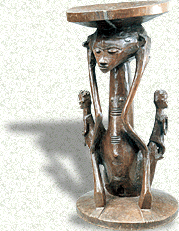
Caryatid stool. Pende. Bandundu/West Kasai, Zaïre.
Wood.
© Africa-Museum, Tervuren

|
|

The ethnic groups whose art is shown
here have much in common with the preceding groups, particularly the Yaka
and Suku. All have been influenced to varying degrees as much by the culture
of the eastern Kongo groups as by the Luunda. The Holo form a "hinge" group,
from between the north (Suku and Pende) and the south (Tshokwe and Luunda),
between Angola and Zaïre. The Mbala, Holo, Hungaan and Pende all share
the tradition of erecting a giant female figure over the houses of chiefs.
Finally, all these groups, like the preceding ones, maintain the custom of
mukanda. It is interesting to note, however, that while the significance of
this circumcision ritual and its practice is similar throughout the Kwango
groups, the masks that are worn for the occasion differ considerably in form
and style from one ethnic group to another, and even from one region to the
next within a single ethnic group.
The Pende world includes three cultural and — most importantly —
stylistic groups: the Pende from the left bank of the Kwilu River, the
central Pende and the Pende of the Kasai. The munyangi mask decorated with
touraco feathers is characteristic of the Kasai Pende. The central Pende of
the Gatundo chiefdom have developed their own easily recognizable style of
mask known as katundu, which has triangular eyes with half-closed lids, a
turned-up nose with slightly flattened nostrils, and most important an
eyebrow that forms a "W" in reverse relief and continues under the eyes.
This style is especially characteristic of mbuya-type masks, which were
formerly worn at dances held at the close of mukanda. The Pende have
fashioned marvelous miniature replicas called ikhoko. These ivory pendants
played a therapeutic and protective role against certain dangers associated
with the masks, warding off, in particular, evils likely to strike those who
break the rules of the circumcision rites. The katundu style was so
successful that the western Pende and a few neighbouring ethnic groups
adopted its characteristics. Some works, such as the caryatid stool or the
helmet mask from the left bank of the Kwilu River are, nonetheless,
difficult to identify within the Pende mass and its immediate neighbours.
It is likely that the Mbuun anthropomorphic cup was associated with the
enthronement of chiefs. It is almost certain that the palaver staff was used
by Mbuun or Pende leaders or speakers during conflict resolution.
|
![]()
![]()
![]()
![]()